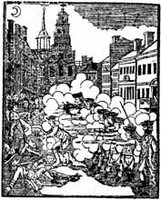The First Newspaper Reports on the Massacre
 In colonial Boston, some newspapers published each Monday, and some each Thursday. Because the Boston Massacre occurred on a Monday evening, the first press reports appeared on Thursday the 8th—237 years ago today. The Massachusetts Gazette and Boston News-Letter listed the casualties this way:
In colonial Boston, some newspapers published each Monday, and some each Thursday. Because the Boston Massacre occurred on a Monday evening, the first press reports appeared on Thursday the 8th—237 years ago today. The Massachusetts Gazette and Boston News-Letter listed the casualties this way:
Mr. Samuel Gray, Ropemaker, killed on the Spot, the Ball entred his Head broke the Skull.What seems off about this list? Well, for one thing, though people expected apprentices Christopher Monk and John Clark to die shortly, neither did. Monk remained disabled by his wound for several years before dying, so he’s not memorialized among the standard five Massacre victims.
A Mollatto Man, named Johnson, who was born in Framingham, but lately belonging to New-Providence, and was here in order to go for North-Carolina, killed on the Spot, two Balls entering his Breast.
Mr. James Caldwell, Mate of Capt. Morton’s Vessel, killed on the Spot, two balls entering his Breast.
Mr. Samuel Maverick, a promising Youth of 17 Years of Age, Son of the Widow Maverick, and an Apprentice to Mr. Greenwood, Joiner, mortally wounded, a Ball went through his Belly, and came out at his Back: He died the next Morning.
A Lad named Christopher Monk, about 17 Years of Age, an Apprentice to Mr. Walker, Shipwright; Mortally wounded, a Ball entered his Side and came out of his Back; apprehended he will die.
A Lad named John Clark, about 17 Years of Age, whose Parents live at Medford, and an Apprentice to Capt. Samuel Howard of this Town; Mortally wounded, a Ball entered just above his Groin and came out at his Hip, on the opposite side, apprehended he will die.
Mr. Edward Payne, of this Town, Merchant, standing at his Entry Door, received a Ball in his Arm, and shattered some of the Bones.
Mr. John Green, Taylor, coming up Leverett’s Lane, received a Ball just under his Hip, and lodged in the under Part of his Thigh, which was extracted.
Mr. Robert Patterson, a Seafaring Man, who was the Person that had his Trowsers shot thro’ in [Ebenezer] Richardson’s affair, wounded; a Ball went thro’ his right Arm.
Mr. Patrick Cole, about 30 Years of Age, who work’d with Mr. Field Leather- Breeches-maker in Queen-Street, wounded, a Ball entered near his Hip and went out at his Side.
A Lad named David Parker, an Apprentice to Mr. Eddy the Wheelwright, wounded, a Ball entered his Thigh.
The Boston Gazette, published the same day, ran a similar list, emphasizing the three wounded apprentices ahead the working-men. The Gazette also gave different names for two men. The first was Patrick Carr, an Irish-born laborer I’ll have more to say about soon. While the two apprentices survived, Carr turned out to have been mortally wounded.
The Gazette also reported the one name people today are most likely to connect to the Boston Massacre: Crispus Attucks. Apparently he was living in Boston under the alias “Michael Johnson,” the name on the coroner’s report on his death (now in the collections of the Old State House Museum). Both the News-Letter and the Boston Chronicle reported the mulatto sailor’s name as Johnson. But the Boston Gazette had the name that appeared on all the subsequent legal proceedings, the name that’s come down in history.
Oddly enough, however, the News-Letter and Gazette had the same description of the man’s history: born in Framingham, working as a sailor out of the Bahamas, in Boston between voyages. Both identified him as mulatto, and therefore didn’t grant him the honorific title of “Mr.” In the 1850s historians found a newspaper ad that implied Attucks had escaped from slavery in Framingham twenty years before, which would explain why he used an alias while back in his home province. But how Bostonians discovered the history of that dead man, and how details reached one newspaper before the others, is still a gnawing mystery.

No comments:
Post a Comment